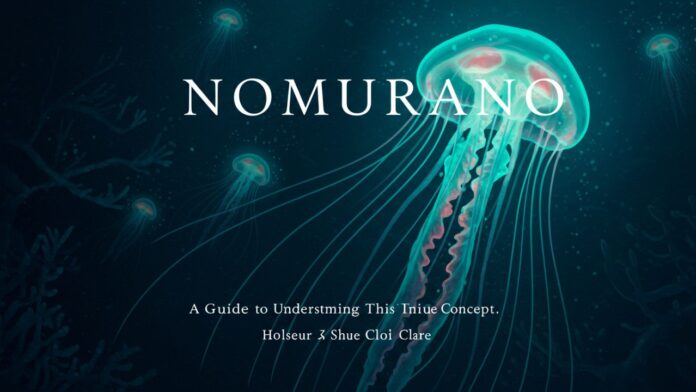Introduction
Within the vastness of Japanese culture and art, there is a centuries-old but very fascinating genre of visual poetry named Nomurano. Extremely dissimilar to the conventional haiku or calligraphy, Nomurano can be discovered in the shapes of abstract image, words, and symbolism combined in an effort to represent one piece of art which defies the limitations of conventional literary style.
The Origins of Nomuraro
A. Historical Roots
Nomurano is said to have emerged in the latter half of the Edo period (1603-1868) of Japan, wherein experimentation in art was common. Although its origins in the past are not well known, there are some authors who venture that it originally developed from Tanka poetry and Zen ink painting (sumi-e) as a combination of written word and visual abstraction.
B. The Impact of Zen Buddhism
Zen Buddhism had a significant impact on Nomuran. “Mu” (void) and “ma” (empty or space) were core concepts within it. Artists tried to induce emotion using an attitude of minimalism so they could leave meaning outside of literal description to the viewer.
Celebrities in poets and Zen masters like Ikkyū Sōjun and Ryōkan Taigu might have indirectly inspired Nomurano’s work in their inquiring style of poetry and art.
C. The Name “Nomurano”
The name “Nomurano” (野村野) has no obvious meaning and is inscrutable. Following are some speculations:
- “No” (野) – Refers to “field” or “wild,” which implies freedom.
- “Mura” (村) – Refers to “village,” which represents community and heritage.
- “No” (野) repeated – Maybe in reference to a return to nature or abstractive inclinations.
Or else because of the artist’s pen name, who got lost to oblivion.
Characteristics of Nomuran Art
Nomuran is not painting or poetry—it is both syncretized. These are its distinguishing characteristics:
A. Synthesis between the Visual and the Textual
In calligraphy, where the written text is meant to be seen, Nomuran utilizes text as visual. Brushstrokes can be rounded in form, dissolving the border of demarcation between image and writing.
B. Imperfection and Asymmetry
Tainted with wabi-sabi (beauty of imperfection), Nomuran rejoices in irregularity. A poem may be asymmetrical, or letters may dissolve into paper, evoking transience.
C. Use of Negative Space
Negative space is deliberate, challenging the viewer’s imagination to fill in meaning. Such use makes mono no aware (pathos of things), the Japanese feeling of profound emotional nuance.
D. Symbolic Imagery
Recurring motifs are:
- Crane (long life)
- Mountains (spiritual quest)
- Water (fluidity of mind)
- Moon (illumination
The symbols are drawn from the text, producing a number of levels of meaning.
E. Fluidity Between Languages
Some of Nomuran pieces utilize the employ of kanji, kana, and even Western alphabet, transcending language barriers. This is evidence of Japan’s earlier exposure to other foreign cultures.
Famous Nomuran Masters
Though Nomuran is shrouded in mystery, its masters have been quoted for their innovations:
A. Unkoku Tōeki (1547-1618)
A hermit monk whose paintings synthesized Zen koans and non-representational brushstrokes, which heralded the paintings of Nomuran.
B. Hasegawa Tōhaku (1539-1610)
More famous for his ink painting, some of his works are poetic writings close to early Nomuran.
C. Contemporary Revivalists
Contemporary artists such as Yoko Ono and Shūsaku Arakawa simply went back to doing it, using word and image in ways similar to Nomuran.
The Cultural Significance of Nomurano
A. A Bridge Between Past and Present
Nomuran is a combination of classical and futurist forms which are still fitting even today. Because it is abstract, it pertains to the movements of contemporary art like Dadaism and Surrealism.
B. A Form of Meditation
It requires a Zen-kind of focus to make Nomuran, wherein the artist must balance intention and freedom. The viewers, to them, actively interpret, thus it is a meditative experience.
C. Influence on Contemporary Design
Graphic designers and typographers borrow from Nomurano’s text-as-painting concept. Brands wishing for a simple but deep look often steal from its principles.
Enjoing (or Making) Nomurano
For Readers:
- Examine the composition – What is text doing with picture?
- Practice ambiguity – Not all strokes need to have a specific meaning.
- Consider emotion – What does the painting stir up in the heart?
For Artists:
- Play with brush and ink – Spontaneity is your ally.
- Wordplay – Rotate, overlap, or remove letters.
Employ symbolism – Employ nature symbols to provide deeper meaning.
Nomurano’s Future
And with growing interest in developing interdisciplinarity in art, Nomurano gets a second wind. Animated Nomurano is being experimented with by computer artists, and text and image replace each other in real time. And AI-generated poetry and art can introduce fresh interpretation to this old-school form.
Conclusion
Nomurano remains Japan’s most enigmatic of arts—a compelling combination of poetry, painting, and philosophy. Its abstraction, space, and depth of feeling guarantee its timelessness. As modern artists continue to rediscover its beauty, Nomuran might yet discover a new generation willing to unravel its mystery.
